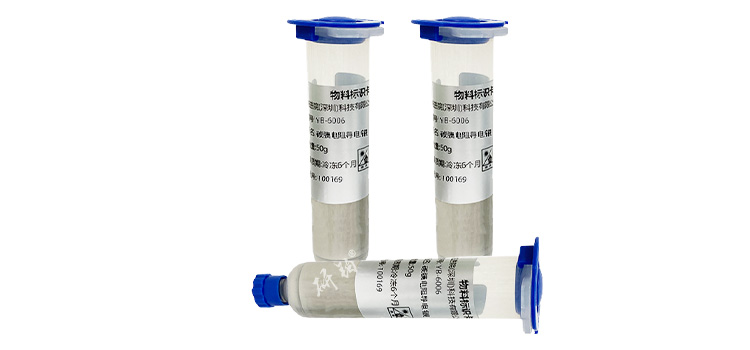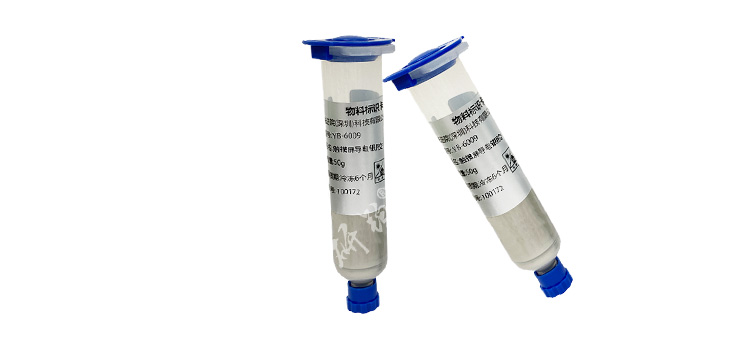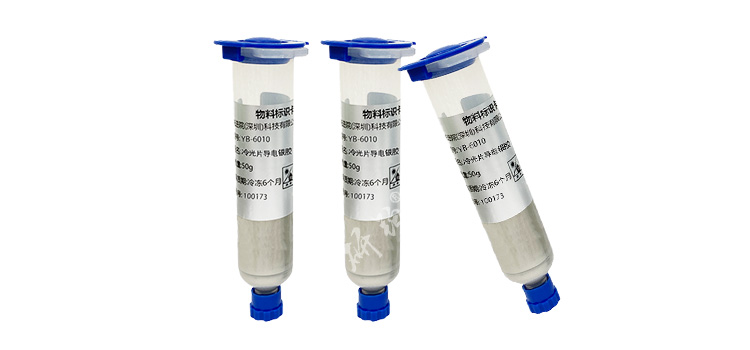

Hotline:0755-22277778
Tel:0755-22277778
Mobile:13826586185(Mr.Duan)
Fax:0755-22277776
E-mail:duanlian@xianjinyuan.cn
Conductive adhesiveIt is a type of adhesive with certain conductive properties after curing or drying, applied to the packaging and bonding of electronic components and components such as liquid crystal displays (LCDs), light emitting diodes (LEDs), integrated circuit (IC) chips, printed circuit board assemblies (PCBA), dot matrix blocks, ceramic capacitors, film switches, smart cards, RF identification, etc. It has a trend of gradually replacing traditional soldering. Conductive adhesive, abbreviated as conductive adhesive, is a type of adhesive that can effectively bond various materials and has conductive properties. The preparation of conductive polymer materials is relatively complex and there is still a long way to go before practical applications, so the widely used ones areFill type conductive adhesive.

Introduction: Conductive adhesive is a type of adhesive with certain conductive properties after curing or drying. It usually consists of a matrix resin and conductive fillers, namely conductive particles, as the main components. Through the bonding effect of the matrix resin, the conductive particles are combined together to form a conductive path, achieving conductive connection of the bonded material Due to the fact that the base resin of conductive adhesive is a type of adhesive, a suitable curing temperature can be selected for bonding, such asepoxy resin adhesiveIt can be cured at room temperature to 150 ℃, much lower than the welding temperature of over 200 ℃ for tin lead welding, which avoids material deformation, thermal damage to electronic devices, and the formation of internal stress that may be caused by high welding temperatures Meanwhile, due to the rapid development of miniaturization and microminiaturization of electronic components, as well as high-density and highly integrated printed circuit boards, the minimum pitch of 0.65mm for lead tin soldering is far from meeting the practical needs of conductive connections. Conductive adhesives can be made into pastes to achieve high line resolution Moreover, the conductive adhesive process is simple and easy to operate, which can improve production efficiency and avoid environmental pollution caused by heavy metal lead in tin lead solder So conductive adhesive is an ideal choice to replace lead tin welding and achieve conductive connections The conductive filler added to the filling type conductive adhesive is usually metal powder. Due to the different types, particle sizes, structures, and amounts of metal powders used, as well as the different types of adhesive substrates used, there are significant differences in the types and properties of conductive adhesives.
After adding a certain metal filler or conductive carbon black to synthetic resin, it becomes conductive. Carbon can be any amorphous carbon, such as acetylene black or crushed graphite powder. existConductive epoxy adhesiveFine silver powder is commonly used in conductive coatings, which has the advantage of appropriate conductivity to salts and oxides, allowing for minimal oxidation or corrosion. The anti-corrosion process is not as important as the thin adhesive layer method, in which interface resistance plays an important role.
Compared to gold, silver is the most suitable conductive filler because it is inexpensive and has low resistance. However, under high temperature and direct current potential conditions, silver undergoes electrolytic migration towards the surface of the adhesive layer, but silver plated copper powder does not migrate, and gold does not migrate either. The maximum amount of silver powder added is about 85% by mass. When the amount of silver powder added is lower than the optimal amount (about 65%), the conductivity is significantly reduced, while the adhesive strength is higher. The conductivity of carbon (graphite) is quite low, far inferior to gold and silver. Other available metal fillers are nickel aluminum and copper, each of which has special oxidation issues. Therefore, compared to spherical metal particles, it is difficult to form particle to particle contact. Unfortunately, the stearate coating on the surface of silver powder releases gas at high temperatures, contaminating critical components such as in microelectronic applications. Some silver powders do not have coatings, so they do not release gas products. Copper and aluminum form an oxide film, which reduces conductivity by hindering particle to particle contact.

There are many varieties of three types of conductive adhesives, and from an application perspective, conductive adhesives can be divided into two categories: general conductive adhesives and special conductive adhesives. General conductive adhesives only have certain requirements for their conductivity and adhesive strength, while special conductive adhesives not only have certain requirements for conductivity and adhesive strength, but also have certain special requirements such as high temperature resistance, ultra-low temperature resistance, instant curing, anisotropy, and transparency.
According to the characteristics of the curing process, conductive adhesives can be divided into curing reaction type, hot melt type, high-temperature sintering type, solvent type, and pressure-sensitive conductive adhesives.
According to the different types of conductive particles in conductive adhesive, conductive adhesive can be divided intoSilver based conductive adhesiveGold based conductive adhesive, copper based conductive adhesive, and carbon based conductive adhesive. The most widely used is silver based conductive adhesive.
According to the chemical type of the base material in conductive adhesive, conductive adhesive is divided into inorganic conductive adhesive and organic conductive adhesive. Inorganic conductive adhesives have good high temperature resistance, but poor adhesion to metals. They mainly include epoxy resin conductive adhesives, phenolic resin conductive adhesives, polyurethane conductive adhesives, thermoplastic resin conductive adhesives, and polyimide conductive adhesives. The most widely used is epoxy resin conductive adhesive. According to the basic composition, it can be divided into two categories: structural type and filling type. Structural type refers to a conductive adhesive in which the polymer material used as the conductive adhesive matrix already has conductivity; Filler type refers to a conductive adhesive that uses adhesive as the matrix and relies on the addition of conductive fillers to make the adhesive liquid conductive.
1) According to the matrix, it can be divided into thermoplastic conductive adhesive and thermosetting conductive adhesive.Thermoplastic conductive adhesiveThe molecular chain of the matrix resin is very long and has few branches. It has good flowability when cured at high temperatures and can be reused. The matrix material of thermosetting conductive adhesive is initially monomers or prepolymers, which undergo polymerization reactions during the curing process. The polymer chains are connected to form a cross-linked three-dimensional network structure, which is not easy to flow at high temperatures.
2) According to the principle of conductivity, it can be divided into intrinsic conductive adhesive and composite conductive adhesive. Intrinsic conductive adhesive refers to a conjugated polymer with a molecular structure that possesses conductive properties. This type of material has high electrical resistivity, poor conductivity stability and repeatability, and high cost, so it is rarely studied. Composite conductive adhesive refers to the addition of conductive fillers to an organic polymer matrix to give it conductivity similar to that of metals. Current research mainly focuses on this aspect.
3) Divided into two categories based on the direction of conductivity: isotropic (ICAs) and anisotropic (ACAs). The former has the same conductivity in all directions; The latter is insulating in the XY direction and conductive in the Z direction. By selecting fillers of different shapes and amounts, isotropic or anisotropic conductive adhesives can be made separately. Both types of conductive adhesives have their own strengths, and current research mainly focuses on the latter.
4) According to different curing systems, conductive adhesives can be divided into room temperature curing conductive adhesives, medium temperature curing conductive adhesives, high temperature curing conductive adhesives, and ultraviolet curing conductive adhesives. Room temperature curing takes too long, usually several hours to several days, and the volume resistivity is prone to change when stored at room temperature, so it is less commonly used in industry. Medium temperature curing conductive adhesive has excellent mechanical properties, and the curing temperature is generally below 150 ℃. This temperature range can better match the operating temperature and temperature resistance of electronic components, making it a widely used conductive adhesive at present.
When high-temperature curing conductive adhesive is used, metal particles are easily oxidized and the curing speed is fast. The curing time of conductive adhesive is required to be short, so it is also used less frequently. UV cured conductive adhesive mainly relies on the irradiation of ultraviolet light to cause the resin matrix to undergo curing reaction, with a fast curing speed. The resin matrix can be stored for a long time under dark conditions, which is a new type of curing method.
5) Conductive adhesives classified by conductive particles can be further divided into gold conductive adhesivesSilver conductive adhesiveCopper conductive adhesive, carbon based conductive adhesive, nano carbon tube conductive adhesive, etc.
Au powder has excellent conductivity and chemical stability, making it the most ideal conductive filler, but it is expensive and generally only used in situations with high requirements. Ag powder has a relatively low price, good conductivity, and is not easily oxidized in air. However, it undergoes electromigration in humid environments, which reduces the conductivity of the conductive adhesive. Cu powder and Ni powder have good conductivity and low cost, but they are prone to oxidation in air, resulting in decreased conductivity. Therefore, conductive fillers are generally selected as Ag or Cu.
The particle size and shape of conductive fillers have a direct impact on the conductivity of conductive adhesives. Fillers with larger particle size have better conductivity than those with smaller particle size, but at the same time, they can lead to a decrease in connection strength. Amorphous (sheet-like or fibrous) fillers have better conductivity and connection strength than spherical fillers. But anisotropic conductive adhesive can only use spherical fillers with narrow particle size distribution. The combination of fillers with different particle sizes and shapes can achieve better conductivity and connection strength.

Four components
Conductive adhesive is mainly composed of resin matrix, conductive particles, dispersing additives, and additives. The matrix mainly includes epoxy resin, acrylic resin, polyvinyl chloride ester, etc. Although highly conjugated polymers themselves have conductivity in their structure, such as pyridine like structures, which can conduct electricity through electrons or ions, the conductivity of such conductive adhesives can only reach the level of semiconductors at most, and cannot have the same low resistance as metals, making it difficult to achieve conductive connections. Most of the conductive adhesives used in the market are filler type.
Filler type conductive adhesiveIn principle, various types of resin matrices can be used for the resin matrix, including thermosetting adhesives such as epoxy resin, silicone resin, polyimide resin, phenolic resin, polyurethane, acrylic resin, and other adhesive systems. These adhesives form a molecular skeleton structure of conductive adhesive after curing, providing mechanical and adhesive performance guarantees, and enabling conductive filler particles to form channels. Due to the fact that epoxy resin can cure at room temperature or below 150 ℃ and has rich formulation and designable properties, epoxy resin based conductive adhesives dominate. Conductive adhesive requires that the conductive particles themselves have good conductivity and the particle size should be within an appropriate range, which can be added to the conductive adhesive matrix to form a conductive path. Conductive fillers can be powders of gold, silver, copper, aluminum, zinc, iron, nickel, graphite, and some conductive compounds.
Another important component in conductive adhesive is the solvent. Due to the fact that the amount of conductive filler added is at least 50% or moreConductive adhesiveThe viscosity of the resin matrix increases significantly, often affecting the process performance of the adhesive. In order to reduce viscosity and achieve good processability and rheology, in addition to using low viscosity resins, solvents or reactive diluents are generally added. The reactive diluent can be directly used as the resin matrix for reaction curing. Although the amount of solvent or reactive diluent is not large, it plays an important role in conductive adhesives, not only affecting conductivity, but also affecting the mechanical properties of the cured material. Commonly used solvents (or diluents) should generally have a large molecular weight, evaporate slowly, and contain polar structures such as carbon oxygen polar segments in their molecular structure. The amount of solvent added should be controlled within a certain range to avoid affecting the overall bonding performance of the conductive adhesive.
In addition to the resin matrix, conductive fillers, and diluents, conductive adhesives also include crosslinking agents, coupling agents, preservatives, toughening agents, and thixotropic agents, just like adhesives.

Advanced Institute (Shenzhen) Technology Co., Ltd, © two thousand and twenty-onewww.avanzado.cn. All rights reservedGuangdong ICP No. 2021051947-1 © two thousand and twenty-onewww.xianjinyuan.cn. All rights reservedGuangdong ICP No. 2021051947-2